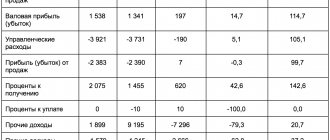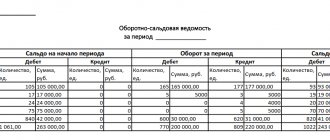Step-by-step instruction
On November 1, the Organization received a loan from a counterparty in the amount of RUB 450,000. for a period of 18 months at 15% per annum. According to the terms of the agreement, the principal amount of the debt is paid in equal installments monthly, interest is accrued monthly on the balance of the debt. Payment of debt and interest is made according to the payment schedule.
On November 30 and December 31, interest was accrued and the principal and interest were paid according to schedule.
Let's look at step-by-step instructions for creating an example. PDF
| date | Debit | Credit | Accounting amount | Amount NU | the name of the operation | Documents (reports) in 1C | |
| Dt | CT | ||||||
| Receiving a loan from a counterparty | |||||||
| November 01 | 51 | 67.03 | 450 000 | 450 000 | Receiving a loan from a counterparty | Receipt to the current account - Receiving a loan from a counterparty | |
| Reflection in the accounting of accrued interest on the loan for November | |||||||
| November 30th | 91.02 | 67.04 | 5 363,01 | 5 363,01 | 5 363,01 | Interest accrual | Manual entry - Operation |
| Payment of loan principal for November | |||||||
| November 30th | 67.03 | 51 | 25 000 | 25 000 | Payment of principal | Write-off from the current account - Repayment of the loan to the counterparty | |
| Payment of interest for November | |||||||
| November 30th | 67.04 | 51 | 5 363,01 | 5 363,01 | Payment of interest | Write-off from the current account - Repayment of the loan to the counterparty | |
| Reflection in accounting of accrued interest on a loan for December | |||||||
| 31th of December | 91.02 | 67.04 | 5 414,38 | 5 414,38 | 5 414,38 | Interest accrual | Manual entry - Operation |
| Payment of loan principal for December | |||||||
| 31th of December | 67.03 | 51 | 25 000 | 25 000 | Payment of principal | Write-off from the current account - Repayment of the loan to the counterparty | |
| Reflection in accounting of accrued interest on a loan for December | |||||||
| 31th of December | 67.04 | 51 | 5 414,38 | 5 414,38 | Payment of interest | Write-off from the current account - Repayment of the loan to the counterparty | |
Receiving a loan from a counterparty
Regulatory regulation
Under a loan agreement, one party (the lender) transfers or undertakes to transfer into ownership the other party (borrower) money, things defined by generic characteristics, or securities, and the borrower undertakes to return to the lender the same amount of money (loan amount) or an equal number of things received by him of the same type and quality or the same securities (clause 1 of Article 807 of the Civil Code of the Russian Federation).
Loan and credit are not the same thing! Under a loan agreement, a bank or other credit organization undertakes to provide funds to the borrower in the amount and on the terms stipulated by the agreement, and the borrower undertakes to return the amount of money received and pay interest for its use, as well as other payments provided for in the loan agreement, including those related to the provision loan (Clause 1, Article 819 of the Civil Code of the Russian Federation).
The main differences between a loan and a loan:
- The loan is issued only by the bank. The loan can be obtained from other legal entities, as well as individuals.
- The loan necessarily requires the payment of interest. The loan may be interest-free.
- The loan is issued exclusively in cash. The loan can be issued in kind or in securities.
- Loans are “subject to” the regulations of the Bank of Russia. For loans between persons other than credit institutions, these regulations may be considered as recommended.
The rules for accounting for loans are described in PBU 15/2008 “Accounting for expenses on loans and credits.” The amount received under the loan agreement is accounts payable and is accounted for depending on the loan term: if the term is up to a year inclusive - in account 66.03 “Short-term loans”, if the term is more than a year - in account 67.03 “Long-term loans” (1C chart of accounts).
The costs associated with the execution of the loan agreement and accounted for separately from the principal debt include (clause 3 of PBU 15/2008):
- interest on the loan;
- associated costs - payment for information and consulting services, contract review, etc.
Related expenses are taken into account evenly throughout the entire term of the loan agreement (clause 8 of PBU 15/2008).
As of June 1, 2021, the legislative regulation of loan agreements has changed significantly. Details As of June 1, 2018, changes to credit and loan agreements came into force.
Accounting in 1C
Receipt of funds under a loan agreement is documented in the document Receipt to current account transaction type Receipt of a loan from a counterparty .
Please pay attention to filling out the fields:
- Amount - the amount received under the loan agreement, according to the bank statement.
- Agreement - loan agreement with Agreement Type - Other .
In our example, payments under the loan agreement are carried out in rubles, the term of the agreement is more than a year. PDF As a result of selecting such an agreement in the document Receipt to the current account, the following is automatically set:
- Settlement account - 67.03 “Long-term loans”.
Postings according to the document
The document generates the posting:
- Dt Kt 67.03 - receiving a loan from a counterparty.
How to reflect in accounting if a legal entity takes a loan from an individual?
212 of the Tax Code of the Russian Federation does not arise for an individual.
Funds received by an organization under a loan agreement are not taken into account either for profit tax purposes or for VAT purposes on the following grounds.
An individual who is not an individual entrepreneur does not become a VAT payer. Therefore, the individual providing the loan (reimbursable or gratuitous) does not calculate VAT. The organization in this case, on the basis of the provisions of Art. 161 of the Tax Code of the Russian Federation is not a tax agent and also does not calculate VAT.
According to paragraphs. 10 p. 1 art. 251 of the Tax Code of the Russian Federation, when calculating income tax, income in the form of funds or other property received under credit or loan agreements (other similar funds or other property, regardless of the method of registration of borrowings, including securities under debt obligations), as well as funds or other property received to repay such borrowings.
The return of an interest-free loan is not reflected by the organization as part of the expenses taken into account when taxing profits, in accordance with clause 12 of Art. 270 Tax Code of the Russian Federation.
Saving on interest under interest-free loan agreements does not entail the emergence of an object of taxation for profit tax for the borrower (letters of the Ministry of Finance of Russia dated 03/14/2007 N 03-02-07/2-44, dated 02/20/2006 N 03-03-04/1/ 128).
Reflection in accounting of accrued interest for November and December
The amount of interest on the loan (or the condition of no interest) is specified in the agreement. If there is no such clause, then interest is paid at the key rate of the Bank of Russia in force during the settlement periods. Exceptions are loans between citizens (including individual entrepreneurs) in the amount of no more than 100 thousand rubles. and loans in kind, which are interest-free by default, unless the agreement provides for other conditions (clause 1, clause 4 of Article 809 of the Civil Code of the Russian Federation).
The accrued interest is reflected in the accounting system (clauses 6-7 PBU 15/2008, clause 5, clause 11, clause 18 PBU 10/99):
- as part of other expenses in the reporting period interest accrual;
- in the initial cost of the investment asset.
In NU, accrued interest is reflected in non-operating expenses:
- for uncontrolled transactions - based on the actual interest rate (clause 2, clause 1, article 265 of the Tax Code of the Russian Federation, clause 1, article 269 of the Tax Code of the Russian Federation);
- for controlled transactions - within the maximum threshold of the key rate of the Central Bank of the Russian Federation or international rates EURIBOR, SHIBOR, LIBOR, depending on the currency of the loan (clause 1.1, clause 1.2 of Article 269 of the Tax Code of the Russian Federation).
As a rule, interest on loans is accrued by analogy with bank loans: from the next day after the amount is received until the day the loan is repaid inclusive - this procedure is provided for in clause 3.14 of the Regulations of the Central Bank of the Russian Federation dated August 4, 2003 N 236-P. However, for loans it is not mandatory, so the contract can provide for a different procedure: for example, establish a fixed amount of interest (clause 2 of Article 809 of the Civil Code of the Russian Federation).
In our example, interest, according to the loan agreement, is accrued on the balance of the debt monthly according to the following formula:
Let's calculate interest for November and December:
In the following months the calculation will be similar.
Accounting in 1C
The accrual of interest is reflected in the document Transaction entered manually, the transaction type Transaction in the section Operations – Accounting – Transactions entered manually:
- in accounting - on account 91.02 “Other expenses”;
- in NU - as part of non-operating expenses.
Interest accrual for November.
Interest accrual for December and subsequent months is processed in the same way.
For more convenient work, you can define a template for reflecting accrued interest in accounting. To do this, you need to create a Standard Operation document in the Operations – Accounting – Standard Operations section.
Accounting entries for loans received
QUESTION
An individual who is not a founder issued an interest-free loan to a legal entity for a period of one year.
What are the tax consequences for an individual?
For this reason, there are no tax consequences for the individual.
In addition, we inform you that relationships under loan agreements are regulated by the Civil Code of the Russian Federation (Chapter 42, paragraph 1 “Loan and Credit”). Moreover, transactions of legal entities between themselves and with citizens must be made in simple written form (Article 161 of the Civil Code of the Russian Federation). Otherwise, it will be difficult to demand its return from the borrower, a legal entity, if he does not fulfill his obligations to return the money. In addition, a transaction with cash or other property is subject to mandatory control if the amount for which it is carried out is equal to or exceeds 600,000 rubles, and by its nature this operation relates to one of the following types of operations - in particular, crediting or transfer to cash account, granting or receiving a credit (loan), transactions with securities in the event that at least one of the parties is an individual or legal entity having, respectively, registration, residence or location in the state (territory) that (s) does not participate in international cooperation in the field of combating the legalization (laundering) of proceeds from crime and the financing of terrorism, or one of the parties is a person who owns an account in a bank registered in the specified state (in the specified territory).
Similarly, other transactions with movable property are subject to control, namely the provision by legal entities that are not credit institutions of interest-free loans to individuals and (or) other legal entities, as well as the receipt of such a loan.
These provisions are provided for by Federal Law No. 115-FZ of August 7, 2001 “On combating the legalization (laundering) of proceeds from crime and the financing of terrorism” (clauses 2 and 4 of Art.
Payment of principal for November and December
Accounting in 1C
Payment of the principal debt is reflected in the document Write-off from the current account type of operation Loan repayment to the counterparty in the Bank and cash desk section - Bank - Bank statements - Write-off.
Please pay attention to filling out the fields:
- Amount - the amount of the principal debt to be paid, according to the bank statement.
- Agreement - loan agreement with Agreement Type - Other .
- Type of payment - Debt repayment .
In our example, payments under the loan agreement are carried out in rubles, the term of the agreement is more than a year. PDF As a result of selecting such an agreement and the type of payment Debt Repayment in the document Write-off from the current account, the following is automatically set:
- Settlement account - 67.03 “Long-term loans”.
Payment of the principal debt for December and subsequent months is processed in the same way.
Postings according to the document
The document generates the posting:
- Dt 67.03 Kt - payment of the principal debt.
Payment of interest for November and December
Accounting in 1C
The payment of interest is reflected in the document Write-off from the current account transaction type Repayment of loan to the counterparty in the Bank and cash desk section - Bank - Bank statements - Write-off.
Please pay attention to filling out the fields:
- Amount - the amount of interest paid, according to the bank statement.
- Agreement - loan agreement with Agreement Type - Other .
- Type of payment - Payment of interest .
In our example, payments under the loan agreement are carried out in rubles, the term of the agreement is more than a year. As a result of selecting such an agreement and payment type, Payment of Interest in the document Write-off from the current account is automatically set:
- Settlement account - 67.04 “Interest on long-term loans.”
Payment of the principal debt for December and subsequent months is processed in the same way.
Postings according to the document
The document generates the posting:
- Dt 67.04 Kt - payment of interest.
Reporting
Long-term loans received are reflected in the balance sheet according to:
- line 1410 “Borrowed funds” - the balance of debt is reflected;
- line corresponding to the investment asset - in the amount of interest taken into account in the cost of acquisition of this asset.
If there is less than a year left until the loan is repaid, it can be transferred to short-term accounts payable. The possibility of transfer must be recorded in the accounting policies of the organization. If the loan is converted to short-term, it will be reflected according to:
- page 1510 “Borrowed funds”.
In the income tax return, the amounts of accrued interest are reflected as part of non-operating expenses: PDF
- Sheet 02 Appendix No. 2 page 201 “Expenses in the form of interest on debt obligations...”
In the income statement, accrued interest is reflected according to:
- page 2330 “Interest Payable.”
See also:
- Purchasing materials using loan funds
- Purchase of fixed assets using loan funds
- What is the difference between a founder's loan and financial assistance?
- Financial assistance from the founder: features of registration and taxation
- Loan forgiveness by the founder
- Changes regarding the conclusion of credit and loan agreements came into force on June 1, 2018
Did the article help?
Get another secret bonus and full access to the BukhExpert8 help system for 14 days free of charge
An organization provides a loan to an individual
6).
The issuance of an interest-free loan by an individual (regardless of who it is issued to) does not entail the receipt of income by this person. In addition, when issuing an interest-free loan in cash to a legal entity, VAT is not charged, since operations for the provision of financial services for the provision of a loan in cash are exempt from taxation (clause 15, clause 3, article 149 of the Tax Code of the Russian Federation).
Income is recognized as an economic benefit in monetary or in-kind form, taken into account if it is possible to assess it and to the extent that such benefit can be assessed, and determined in accordance with Chapter 23 “Personal Income Tax” of the Tax Code of the Russian Federation. Based on Articles 208 and 209 of the Tax Code of the Russian Federation, the object of taxation is income received by the taxpayer, both from sources in Russia and abroad.
Alla Timofeeva, member of the Chamber of Tax Consultants, leading auditor of CJSC Auditorskaya
Currently, organizations in the form of a limited liability company are popular business entities in Russia. The legal status of a limited liability company, the rights and obligations of its participants are determined by the Civil Code of the Russian Federation and Federal Law No. 14-FZ dated 02/08/1998 “On Limited Liability Companies” (hereinafter referred to as the LLC Law).
To conclude an interest-free targeted loan agreement, the organization (lender) is obliged to prepare a package of documents before transferring the money into the ownership of an individual (borrower), and then the borrower - an individual will be obliged to return the same amount of money (loan amount) to the lender.
The organization (lender) needs to prepare so that transactions, including the conclusion of a loan agreement, are recognized as legal in the light of the requirements of the LLC Law, and the individual (taxpayer) who received the loan does not receive income in the form of material benefits: from the amount of savings on percent, expressed in rubles, calculated on the basis of two-thirds of the current refinancing rate established by the Central Bank of the Russian Federation on the date of actual receipt by an individual (taxpayer) of the income provided for in paragraph 2 of Art. 212 of the Tax Code of the Russian Federation. And also, so that the organization as a tax agent does not have the obligation to calculate, withhold and transfer tax on personal income to the budget at a rate of 35% (clause 2 of Article 224 of the Tax Code of the Russian Federation) or to report to the tax authorities about the impossibility of withholding tax in the form No. 2-NDFL (clause 5 of article 226 of the Tax Code of the Russian Federation).
Thus, if an organization intends to issue a loan to an individual for new construction or for the acquisition on the territory of the Russian Federation of a residential building, apartment, room or share(s) in them, land plots provided for individual housing construction, and land plots on which purchased residential buildings, or shares (shares) in them, and receiving exemption from personal income tax, then in order to carry out the intention, the following algorithm of actions should be followed.
1. Receive an application from an individual requesting a loan indicating detailed information: loan amount, for what purpose, for what period, repayment procedure, etc.:
2. An application received from an individual is considered by an extraordinary meeting of participants (founders) of the company to make a decision on approval of the transaction. According to the agenda, the general meeting of founders may simultaneously consider two issues to confirm the legality of the transaction on the provision of a loan by the company to an individual:
The first question is about the approval by the general meeting of company participants of a major loan transaction in accordance with the requirements of clause 1 of Art. 46 of the LLC Law. A transaction in the form of a loan is a major transaction if its amount is twenty-five percent or more of the value of the company’s property, determined on the basis of financial statements for the last reporting period preceding the day the decision to grant the loan was made.
The second question is about the approval by the general meeting of the company’s participants of the provision of a loan to an interested person in accordance with the requirements of clause 1 of Art. 45 of the LLC Law. In this case, interested parties may be the founder of a limited liability company; the person performing the functions of the sole executive body of the company (general director, president); member of the board of directors (supervisory board) of the company; an interested participant in a company that, together with its affiliates (spouses, parents, children, brothers, sisters and (or) their affiliates), has twenty or more percent of the votes of the total number of votes of the company's participants, as well as with a person who has the right to give mandatory instructions for him.
Approval of a transaction to issue a loan to an individual is formalized by the minutes of the general extraordinary meeting of the founders of the company.
Next, an interest-free targeted loan agreement is concluded in simple written form, according to which the organization undertakes to provide an individual (borrower) with an interest-free targeted loan, and the latter undertakes to use it for its intended purpose and repay the loan within the period specified in the agreement (clause 1, article 161, clause 1, Article 808 of the Civil Code of the Russian Federation).
The interest-free targeted loan agreement is considered concluded from the moment the money is transferred (clause 1 of Article 807 of the Civil Code of the Russian Federation). Since the borrower is an individual, the loan amount can be provided to him either in cash or by bank transfer at the request of the parties to the agreement (clause 1 of Article 861 of the Civil Code of the Russian Federation).
3. To correctly decide on the procedure for transferring money under an interest-free targeted loan agreement, we will consider the rules indicating the rules for conducting cash transactions.
Firstly, clause 2 of the Directive of the Central Bank of the Russian Federation No. 1843-U establishes a closed list of purposes for which an organization can spend cash proceeds, where the issuance of a loan is not provided. Therefore, if an organization decides to provide a loan to an individual in cash, then you must first deposit the cash proceeds to the bank, and then withdraw the required amount from the account and issue the money to the individual from the cash desk under the loan agreement. At the same time, the organization’s expenses for banking services increase: delivery of proceeds plus receipt of cash by check.
Secondly, to receive a loan both in cash and by non-cash transfers in amounts exceeding the amount of 600,000 (Six hundred thousand) rubles from the organization’s current account, it is necessary to provide a complete package of documents to the credit institution (bank) for the interest-free loan agreement provided by the organization to an individual. This follows from Art. 6 of the Federal Law of 07.08.2001 No. 115-FZ “On combating the legalization (laundering) of proceeds from crime and the financing of terrorism.”
Funds are transferred from the current account according to the details specified by the borrower in the loan application.
4. In the interest-free targeted loan agreement, it is necessary to highlight several important points:






